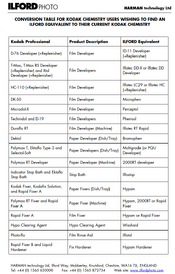dcy
Subscriber
A few months ago Flic Film released the "Elementary B&W Developing Kit". It is a two-part developer whose defining feature is that the dev time is the same regardless of film --- but the fix time is longer for T-grain film.
Part A: Fill the tank with Part A. Agitate for 3 min and return to storage container. Do not rinse between dev steps.
Part B: Fill the tank with Part B. Agitate for 3 min and return to storage container.
Rinse: Rinse with water for 15 sec
Fixer: Fill the tank. Agitate for 4 min and return to storage container.(6.5 minutes for T-Grain films)
Rinse: Rinse with water for 5 min
Wetting Agent: Apply wetting agent directly on the film (Do not reuse) Hang film to dry in a dust free location.
Here are the links to the website, instructions, and developer MSDS.
Part A is Sodium sulfite + Hydroquinone + Metol.
Part B is Sodium sulfite + Borax.
What do y'all think? The sample photos I've seen look good to me, but what do I know?
Flic Film doesn't exactly have a large chemistry R&D team. It is likely that this recipe is a known recipe from the internet (e.g. their Black, White, and Green developer is PC-TEA).
Not gonna lie. I love the idea of a developer that's the same for all films. That's especially useful when I want to experiment with uncommon film stocks like Wolfen NP100, that might not have listed times for your favorite developer in the Massive Dev Chart.
Part A: Fill the tank with Part A. Agitate for 3 min and return to storage container. Do not rinse between dev steps.
Part B: Fill the tank with Part B. Agitate for 3 min and return to storage container.
Rinse: Rinse with water for 15 sec
Fixer: Fill the tank. Agitate for 4 min and return to storage container.(6.5 minutes for T-Grain films)
Rinse: Rinse with water for 5 min
Wetting Agent: Apply wetting agent directly on the film (Do not reuse) Hang film to dry in a dust free location.
Here are the links to the website, instructions, and developer MSDS.
Part A is Sodium sulfite + Hydroquinone + Metol.
Part B is Sodium sulfite + Borax.
What do y'all think? The sample photos I've seen look good to me, but what do I know?
Flic Film doesn't exactly have a large chemistry R&D team. It is likely that this recipe is a known recipe from the internet (e.g. their Black, White, and Green developer is PC-TEA).
Not gonna lie. I love the idea of a developer that's the same for all films. That's especially useful when I want to experiment with uncommon film stocks like Wolfen NP100, that might not have listed times for your favorite developer in the Massive Dev Chart.












